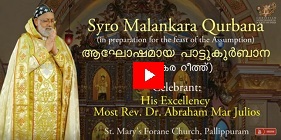Aramaic Project - VI
Interviews and Performances - Video List
No. 10 to 1
Goto No. - 4 | 3 | 2 | 1| Aramaic Project Number | Description | Duration | Date of Recording | Place of Recording | Video |
|
|
Syro-Malankara Qurbana ആഘോഷമായ പാട്ടു കുർബാന. Bishop Abraham Mar Julios. Syro Malankara Solemn High Mass by His Excellency, Bishop Abraham Mar Julios, Bishop Emeritus of Diocese of Muvattupuzha; celebrated on 13 August 2021 at St. Mary's Forane Church, Pallippuram, in preparation for the feast of the Assumption of our Lady. Aramaic Project AP VI : Syro Malankara Church. Note: We are glad to start Aramaic Project-Part VI with the video of the solemn celebration of Qurbana in the Antiochene rite of the Syro Malankara Catholic Church. The Celebrant is Most Rev. Dr. Abraham Mar Julios, Bishop emeritus of the Diocese of Muvattupuzha. The celebration took place on 13 August 2021 at St. Mary's Forane Church, Pallippuram, Cherthala. The occasion was preparation for the principal feast of the parish, the Assumption of our Blessed Mother. There are many aspects of this Qurbana that students and scholars might be interested in studying the history of Catholic liturgies. The prayers, rituals, chants, musical style in this Qurbana is different. For example, the text, melody, style of chanting, and performance practice of the Malayalam version of the Trisagion are considerably different from those of the Syro Malabar Church. They all add to the musical treasures of Kerala and deserve attention from musicologists of any religious affiliation. Because these melodies belong to the category of intercultural music and are part of Kerala's cultural and religious histories. We hope scholars in related fields will use this video as a primary source for their researches. Dr. Joseph J. Palackal, CMINew York 25 August 2021 Keywords - Bp Abraham Mar_Julios, BpJulios, BishopEmeritus, DioceseofMuvattupuzha, ,Syro_Malankara_Church, Malankara_Reethu, Malankara_rite, HolyMass, SolemnMass , SolemnHighMass, Pallippuram, PallippuramPalli, SyroMalabarChurch, CatholicChurch |
59:15 | 13 August 2021 | St. Mary's Forane Church, Pallippuram, Cherthala. |  |
| AP 246/VI/1A |
ത്രൈശുദ്ധ കീർത്തനം - TRISAGION during Malankara Qurbana. See full Qurbana at Aramaic Project-246/VI/01 https://youtu.be/xVIGOV-VTUw Note: The Trisagion (Greek, "Thrice Holy") is an essential component, especially of the Eastern liturgies (both Qurbana and the Hours). The chant originated in the fifth century, probably among the Greek-speaking Christians in Antioch. Because of the theological significance of the text, the Syriac churches adopted the chant in Syriac translation. The common source for the text is Isaiah 6:3 and Rev 4:8. Semantically, the opening verse may have two different connotations: one declaratory, as in "God is holy" (as we sing in the Anthem of the Mysteries: "Let us all join with heavenly choir and sing, God is Holy, Holy, Holy forever"); and the other vocative as in "O God, you are holy." This video shows the Malayalam translation of the chant from the Qurbana in the Antiochene Rite of the Syro Malankara Church in Kerala. Here is the West Syriac version with the addition of a trope, "who was crucified for us." The Syro Malabar Church and the Church of the East use the chant without the trope. The Syriac churches employ different melodies for the chant. We do not know if these versions have a common source either in the Greek or West Syriac traditions. It is a topic for further research. The performance practice of the chant in this video deserves attention. As expected, there are three iterations of the text and melody. The celebrant sings the first verse (O God Thou art holy). The choir sings the other three verses, including the trope (who was crucified for us). The trope gets a special treatment. While the choir sings the trope, the celebrant and the deacon bow down and bless themselves; the server rings the handbell. In general, the melody revolves around a minor tetrachord: G – A – Bb – C (Sa – Ri – Ga –Ma). There are two exceptions. While ornamenting the final vowel sound of the vocative “Daiwame” in the opening verse, the Bishop reaches out to the fifth degree of the scale. The choir, however, remains within the tetrachord in the rest of the verses. In contrast, in the final verse, the choir descends a halftone below the tonic on the phrase, “njangalodu.” The overall mood of the melody seems to be one of supplication in the final verse, "Have mercy on us." In conclusion, the structure of text and melody is more elaborate in the Antiochene tradition than the East Syriac tradition. We hope this video will inspire someone to take up a comparative study of Trisagion's text, melody, and theology. Reference: Alencherry, Joseph Roby. "The Rite of Trisagion in the Syro Malabar Church." In Christian Orient. Vol. XXXII, no. 3 (September 2011), pp. 137-152. Joseph J. Palackal, CMINew York 17 September 2021 |
8:55 | 13 August 2021 | St. Mary's Forane Church, Pallippuram |  |